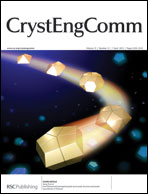A series of six cyanide-bridged heterobimetallic complexes including {[M(L)2]2[Mn(TPP)]}[Mn(TPP)(MeOH)2]·xH2O·yMeOH {L = 1,2-bis(pyridine-2-carboxamido)-4-methylbenzenate (bpb2−), M = Cr (1), Co (2); L = 1,2-bis(pyridine-2-carboxamido)benzenate (bpmb2−), M = Cr (3), Co (4); TPP = meso-tetra(phenyl)porphyrin} and {[M(bpb)(CN)2][Mn(TClPP)(MeOH)]}·xH2O·yMeOH {M = Cr (5), Co (6), TClPP = meso-tetra(4-chlorophenyl)porphyrin} were designed and synthesized with two manganese(III)–porphyrin compounds and four pyridinecarboxamide dicyanidemetalates as building blocks. X-ray diffraction analysis reveals that compounds 1–4 containing the [Mn(TPP)]+ ion connect two dicyanide-containing [M(L)(CN)2]− anions to form the anionic trinuclear sandwich-like MIII–MnIII–MIII molecular moiety with the one [Mn(TPP)(CH3OH)2]+ segment as a balance cation. The MIII–MnIII complexes 5 and 6 show a dinuclear molecular conformation comprised of [M(bpb)(CN)2]− and [Mn(TClPP)(MeOH)]+ ions bridged by one cyanide group linking the MnIII ion. Investigation of magnetic properties of the cyanide-bridged Cr–Mn complexes reveals the weak antiferromagnetic interaction between MnIII and CrIII magnetic centers with JMnCr = −0.116(2), −0.092(2) and −0.86(2) cm−1 for 1, 3, and 5, respectively.

You have access to this article
 Please wait while we load your content...
Something went wrong. Try again?
Please wait while we load your content...
Something went wrong. Try again?


 Please wait while we load your content...
Please wait while we load your content...